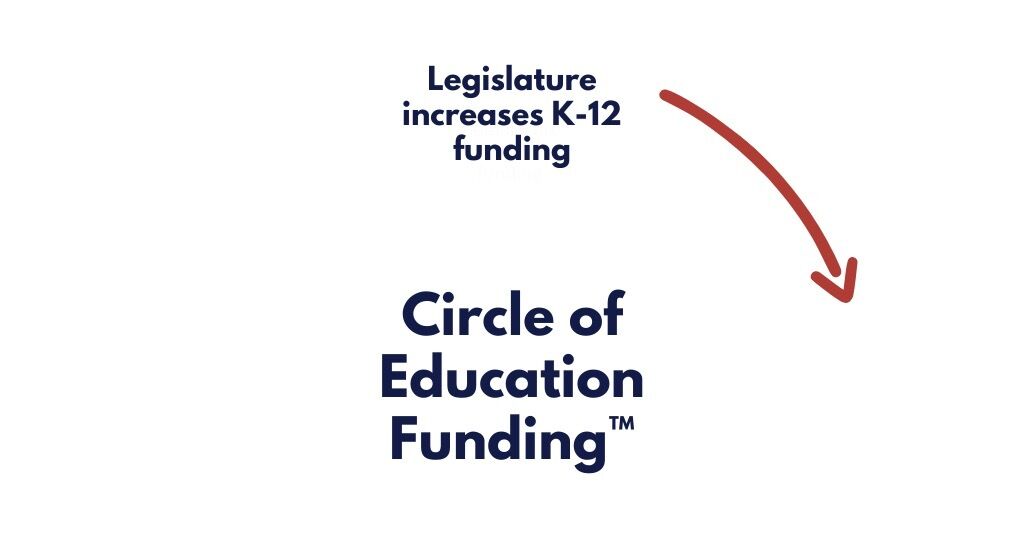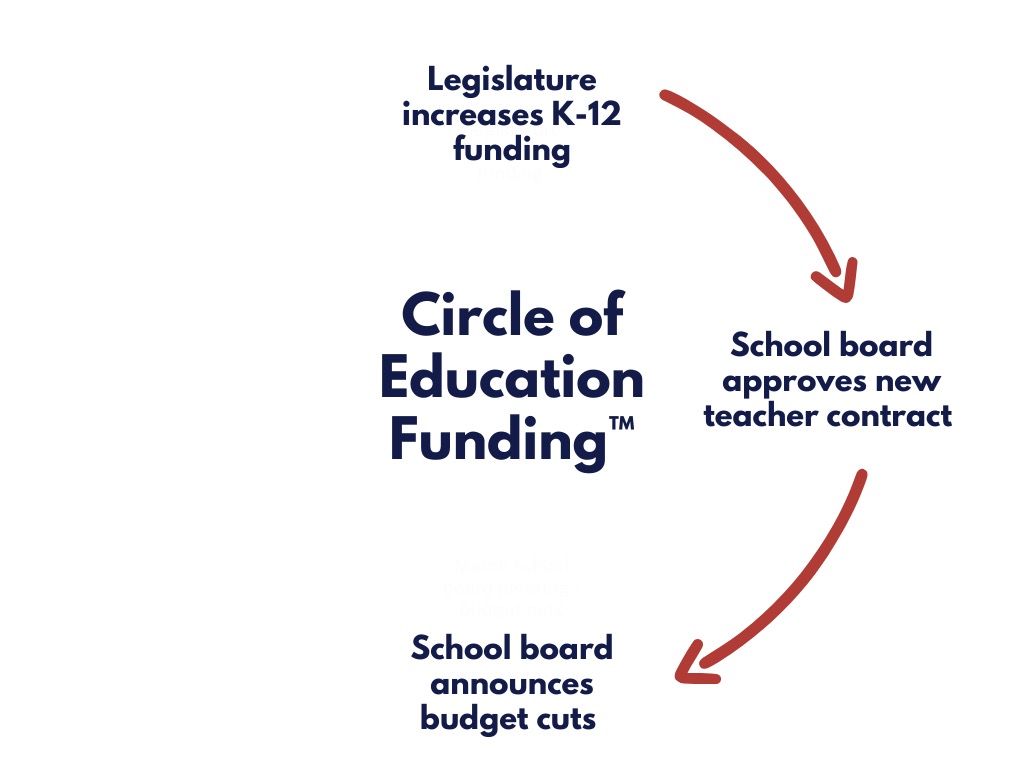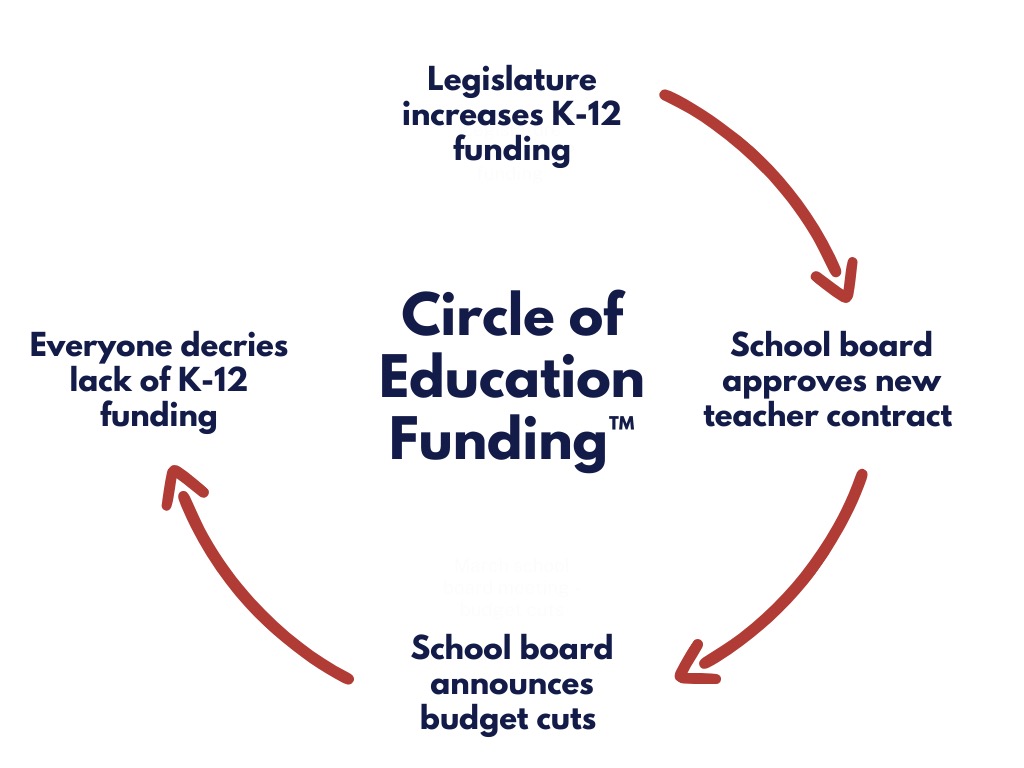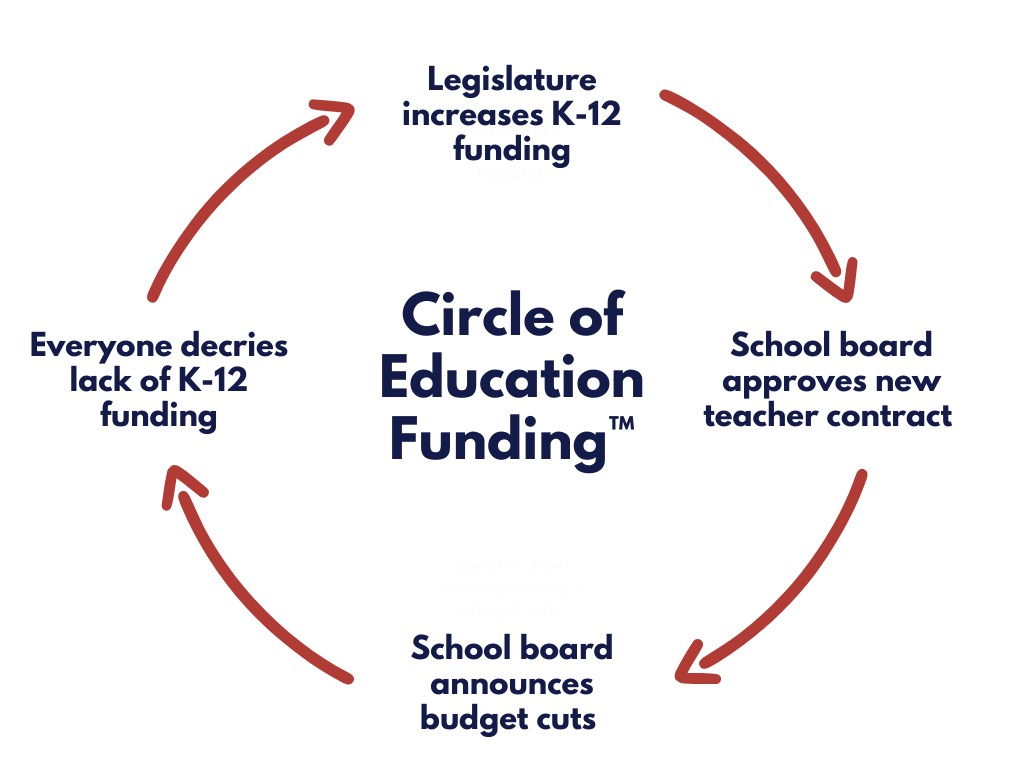The Circle of Education Funding™
Like clockwork, every few months a Minnesota news outlet writes about a local school district facing budget cuts. Sometimes the story is tied to an upcoming (or recently defeated) ballot initiative to secure more funding from property taxpayers. Sometimes it’s connected to a hearing where the school board is meeting to discuss budget cuts, new school boundaries or even school closures. All of the stories share one thing in common: They fail to mention the cost of the district’s latest teacher contract settlement, even though it represents the most expensive item in every school budget.
The stories about local school district funding woes illustrate perfectly the phenomenon known as the Circle of Education Funding™. The Circle of Education Funding has been happening over and over again in Minnesota for decades, with no end in sight.
Why does it always seem like schools never have enough money? Watch Bill Walsh break down the Circle of Education Funding™ below ⬇️ pic.twitter.com/u9QJfF7mRN
— Center of the American Experiment (@MNThinkTank) November 29, 2023
The Circle begins at the top, with the Minnesota Legislature increasing state funding for K-12 schools. It happens every budget year no matter which party controls the House and Senate. Total state expenditures for K-12 schools in Minnesota increased from $10.423 billion in 2002-03 to $24.258 billion in 2024-25. That’s a 133% increase in 22 years, way more than the rate of inflation.

Once the dust settles on the K-12 funding increase, the Minnesota Department of Education produces “runs” for each local school district. The next part of the Circle of Education Funding involves local teacher unions using these public “runs” to determine how much money their school board will have available for the next budget. This gives them a remarkably strong position at the bargaining table as negotiations begin on their contract. It’s hard for the school board to say “we can’t afford that” when the union knows exactly how much money will be in the bank.

Teacher unions in Minnesota have the upper hand in these negotiations in two other ways. First, they get involved in elections by endorsing and supporting candidates for the school board. In fact, licensed teachers are now running for and winning school board seats in their home districts. Even though they may teach in a different school district, a built-in conflict of interest remains. Second, the potential disruption of a teacher strike makes most school board members too scared to call their bluff.
The result is teacher contract settlements that eat up every penny in new state money. Sometimes the union negotiates for more than the district can afford, as we saw in the last Minneapolis settlement. It was no coincidence that the Minneapolis superintendent resigned immediately after signing that unaffordable contract.
Since schools are mostly a people-intensive enterprise, upwards of 75% of the average school budget is comprised of salaries and benefits. Once the school board agrees to their union contracts, only 25% of the budget remains available for balancing.
Final teacher contract settlements need to be ratified by a vote of the school board frequently at their November or December meeting, often on the board’s consent calendar. There is very little discussion. The room is empty. The press rarely mentions it, let alone reports on the dollar cost increase of the contract.
Fast forward a few months to March and a different story emerges. The district announces it is facing a huge budget deficit and must make deep cuts in order to balance the budget. The budget cut proposals include eliminating the middle school band program, cutting Spanish instruction, making students walk farther to school and raising fees for football and other sports. Remember, because the union contracts have been signed, only 25% of the budget is available for cutting.

This meeting of the school board is packed with angry parents. The press is there reporting about the proposed cuts. The superintendent and school board members lament their tough decisions. Some propose going out to the voters to increase operating revenue. There is much weeping and gnashing of teeth.
Which leads us to the final part of the Circle of Education Funding, the blame game. Everyone must lobby the Minnesota Legislature to increase funding for K-12 schools! These horrible cuts are evidence our schools are underfunded.

And thus, the circle continues, round and round, year after year, Democrats and Republicans, urban schools, suburban schools, rural schools. The legislature appropriates more money, the unions grab it for salaries, the school board cuts middle school band, and everyone blames the legislature for underfunding. Rinse and repeat.

How do we break the circle?
The key to breaking the Circle of Education Funding is placing more attention on the teacher contract settlement every two years. Teachers are paid based on a system of steps and lanes. For every year a teacher completes, they automatically move up a step, not matter how their students perform. For every new milestone, such as a master’s degree, the teacher moves over a lane, no matter if the degree is even relevant to what they’re teaching. Since the pay scale is tied to the steps and lanes, each move means more money automatically. When you read in the paper that teachers received a 2% raise, that means the entire scale was increased by 2%. In this system, a 10-year teacher who recently completed their master’s degree could be in line for a much larger raise than 2%.
If a local community values their teachers and supports using the new money from the legislature each year for increased salaries, good for them. As long as everyone knows the ramifications to the rest of the school budget.
If a local community thinks a teacher with 10 years of experience and a master’s degree can get by with a 9-month contract of $68,000, that’s ok too. Transparency is the key.